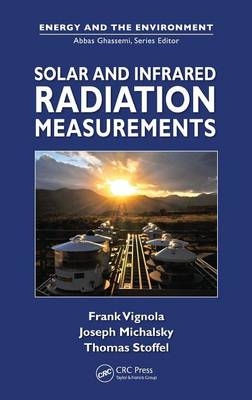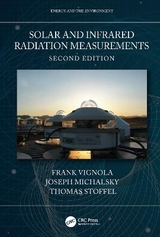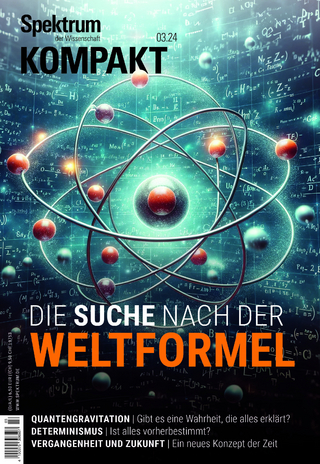
Solar and Infrared Radiation Measurements
Crc Press Inc (Verlag)
978-1-4398-5189-0 (ISBN)
- Titel erscheint in neuer Auflage
- Artikel merken
Topics covered include:
Radiometer design and performance
Equipment calibration, installation, operation, and maintenance
Data quality assessment
Methods to use measured data to estimate irradiance for any surface
With a broad range of content that will benefit students and more experienced readers alike, this resource serves as a primer and technical reference that presents the basic terminology and fundamentals for resource assessment. It explores the history of solar radiation instruments and addresses direct normal, global, diffuse, and tilted measurements, as well as the characteristics of instruments used for these measurements. The authors consider methods of assessing the uncertainty of solar measurements and then cover albedo, infrared, net, and spectral irradiance measurements and instrumentation. The book devotes a section to other meteorological instruments, and another to the basics for installing and operating a solar monitoring station. Appendices include information on solar resource assessment modeling and satellite-derived irradiance, along with other useful material.
This book’s authors are experts who each have more than 30 years of experience developing and operating multiple measurement stations, working with industry to improve radiometry, and conducting various research projects.
Frank Vignola is the director of the University of Oregon (UO) Solar Energy Center. He received his B.A. in physics at the University of California–Berkeley in 1967 and his Ph.D. in elementary particle physics at the UO in 1975. Deciding to apply his skills to more practical applications he started working in solar energy at the UO in 1977. Vignola helped establish and manage the UO solar radiation monitoring network that has the longest-running high-quality solar radiation data set in the United States. He has organized a number of solar resource assessment workshops and has written and contributed to approximately 100 papers in the field. He is currently an associate editor for solar resource assessment for the Solar Energy Journal. Joseph Michalsky is a physical scientist in the Earth System Research Laboratory within the National Oceanic and Atmospheric Administration (NOAA). Prior to NOAA he was with the Atmospheric Sciences Research Center at the State University of New York–Albany. He began his career at the Department of Energy’s Pacific Northwest National Laboratory. Michalsky received his B.S. in physics at Lamar University and M.S. and Ph.D. in physics at the University of Kentucky. His early career focused on astronomical research before taking on problems in solar energy and the atmospheric sciences. Michalsky has nearly 100 refereed publications in these fields. Thomas Stoffel manages the Solar Resources and Forecasting Group at the National Renewable Energy Laboratory. He received his B.S. in aerospace engineering from the University of Colorado and M.S. in meteorology from the University of Utah. He began his career as an aerospace engineer at the U.S. Air Force Propulsion Laboratory simulating gas turbine engine performance and infrared radiation signatures. In 1978, Stoffel joined the Solar Energy Research Institute (now NREL), where he developed the Solar Radiation Research Laboratory (SRRL) that continues to provide research-quality solar and infrared radiation measurements. Stoffel has more than 80 publications addressing solar resource characterization.
Measuring Solar and Infrared Radiation
Solar Resource Definitions and Terminology
Introduction
The Sun
Extraterrestrial Radiation
Solar Coordinates
Zenith, Azimuth, and Hour Angles
Solar, Universal, and Local Standard Time
Solar Position Calculation
Sunrise and Sunset Times
Global, Direct Normal, and Diffuse Irradiance
Solar Radiation on Tilted Surfaces
Spectral Nature of Solar Radiation
Fundamentals of Thermodynamics and Heat Transfer
Photodiodes and Solar Cell Prerequisites
Models
Historic Milestones in Solar and Infrared Radiation Measurement
Introduction
Earliest Observations of the Sun and the Nature of Light
Nineteenth-Century Radiometers
Operational Radiometers of the Twentieth Century
Recent Advances in Solar Measurements
Direct Normal Irradiance
Overview of Direct Normal Irradiance
Pyrheliometer Geometry
Operational Thermopile Pyrheliometers
Absolute Cavity Radiometers
Uncertainty Analysis for Pyrheliometer Calibration
Uncertainty Analysis for Operational Thermopile Pyrheliometers
Uncertainty Analysis for Rotating Shadowband Radiometer Measurements of Direct Normal Irradiance
Direct Normal Irradiance Models
Historical and Current Surface-Measured Direct Normal Irradiance Data
Measuring Global Irradiance
Introduction to Global Horizontal Irradiance Measurements
Black-Disk Thermopile Pyranometers
Black-and-White Pyranometers
Photodiode-Based Pyranometers
Calibration of Pyranometers
Pyranometer Calibration Uncertainties
Diffuse Irradiance
Introduction
The Measurement of Diffuse Irradiance
Calibration of Diffuse Pyranometers
Value of Accurate Diffuse Measurements
Rotating Shadowband Radiometers
Introduction
The Rotating Shadowband Radiometer
The Multifilter Rotating Shadowband Radiometer
Measuring Solar Radiation on a Tilted Surface
Introduction
Effect of Tilt on Single Black Detector Pyranometers
Effect of Tilt on Black-and-White Pyranometers
Effect of Tilt on Photodiode Pyranometers
Recommendations for Tilted Irradiance Measurements
Notes on Modeling PV System Performance with Photodiode Pyranometers
Albedo
Introduction
Broadband Albedo
Spectral Albedo
Bidirectional Reflectance Distribution Function
Albedo Measurements
Infrared Measurements
Introduction
Pyrgeometers
Calibration
Improved Calibrations
Other Pyrgeometer Manufacturers
Operational Considerations
Net Radiation Measurements
Introduction
Single-Sensor (All-Wave) Net Radiometers
Two-Sensor Net Radiometers
Four-Sensor Net Radiometers
Accuracy of Net Radiometers
A Better Net Radiation Standard
Net Radiometer Sources
Solar Spectral Measurements
Introduction
The Extraterrestrial Solar Spectrum
Atmospheric Interactions
Broadband Filter Radiometry
Narrow-Band Filter Radiometry
Spectrometry
Meteorological Measurements
Introduction
Ambient Temperature
Wind Speed and Wind Direction
Relative Humidity
Pressure
Recommended Minimum Accuracies for Operational Instruments
Setting Up a Solar Monitoring Station
Introduction
Choosing a Site
Grounding and Shielding
Data Logger and Communications
Measurement Interval
Cleaning and Maintenance
Record Keeping
Importance of Reviewing Data
Quality Control of Data
Field Calibrations
Physical Layout of a Solar-Monitoring Station
Appendix A: Modeling Solar Radiation
Appendix B: Solar Radiation Estimates Derived from Satellite Measurements
Appendix C: Sun Path Charts
Appendix D: Solar Position Algorithms
Appendix E: Useful Conversion Factors
Appendix F: Sources for Equipment
Appendix G: BORCAL Report
Appendix H: Sunshine Duration
Appendix I: Failure Modes
| Zusatzinfo | 8 page color insert follows page 272; approx 116 equations; 26 Tables, black and white; 16 Illustrations, color; 213 Illustrations, black and white |
|---|---|
| Verlagsort | Bosa Roca |
| Sprache | englisch |
| Maße | 156 x 235 mm |
| Gewicht | 726 g |
| Themenwelt | Naturwissenschaften ► Physik / Astronomie ► Astronomie / Astrophysik |
| Technik ► Maschinenbau | |
| Technik ► Umwelttechnik / Biotechnologie | |
| ISBN-10 | 1-4398-5189-1 / 1439851891 |
| ISBN-13 | 978-1-4398-5189-0 / 9781439851890 |
| Zustand | Neuware |
| Haben Sie eine Frage zum Produkt? |
aus dem Bereich



